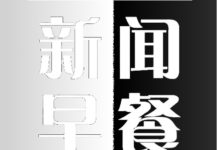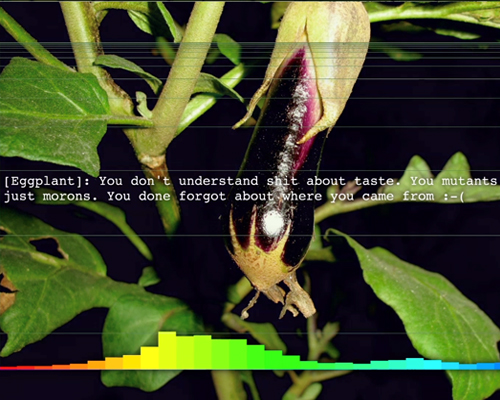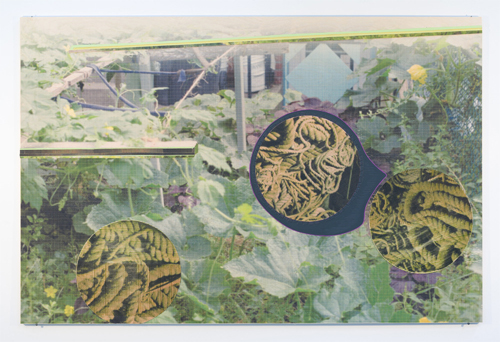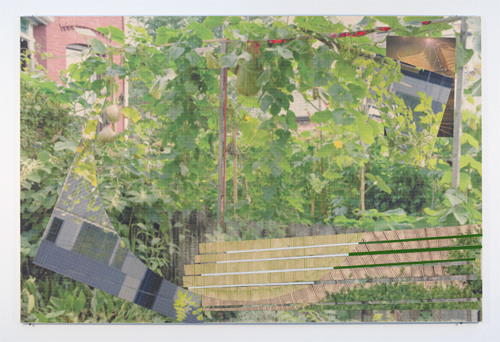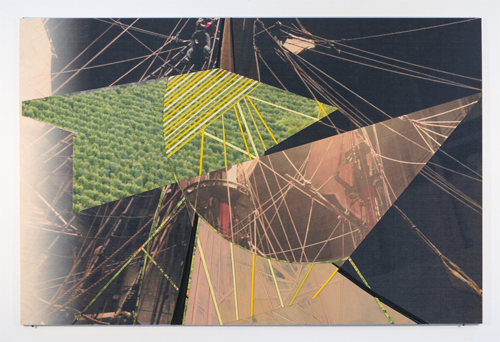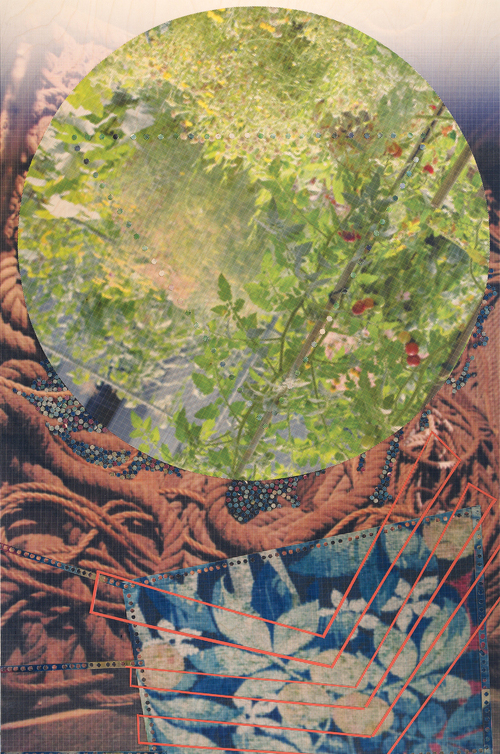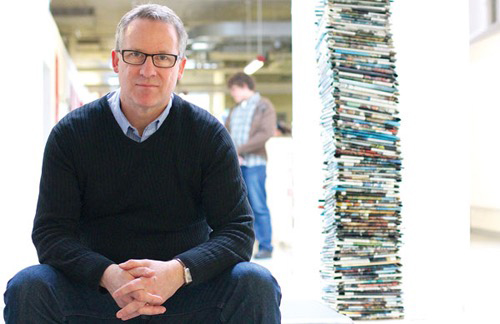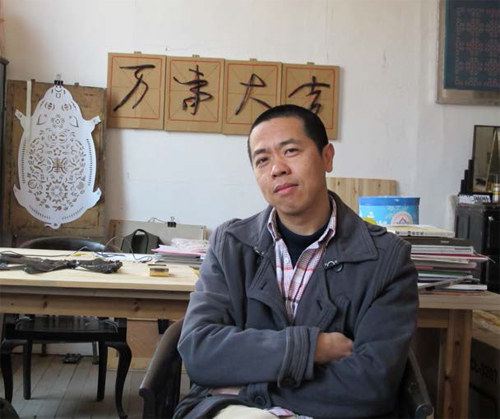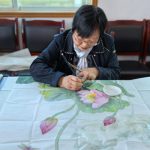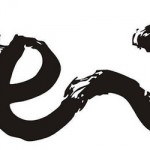
本次展出以Patrick Mahon近作Nosuch Garden为主展,而上海艺术家陈航峰得视频作品不仅可以扩大前者对动物殖民(Colonialism)与园艺的调查,而且还提供不同文化对同意概念的表达。陈航峰的作品范围很广,涉及绘画至剪纸、摄影、视频、表演等。他的作品所关注的话题主要是商业化、环保主义者、全球化以及文化演变对周遭环境的影响,进而通过俏皮的比喻,来表达自己见解。关于该次展览详情如下,或者浏览网页www.katzmancontemporary.com。
Nonsuch Garden is the culmination of Patrick Mahon’s recent artistic activity exploring the visual language of water and its repositories, as well as the vessels that traverse this natural element. This expansive exhibition merges motifs of ships and gardens within a fractured framework of colonialism that looks to a possible future through a lens from the past. Nonsuch Garden visually integrates the dichotomous notions of the natural, organic structure of plant-life itself, with the formal, structural elements of a cultivated garden, and the historical reverberations that this juxtaposition creates. While Mahon’s work is informed by printmaking, the works in this series transcend formal categorization by thwarting conventional practice, and extending materiality through its concepts. Anchoring the exhibition is a titanic collaborative installation piece created with Dickson Bou, “Mastgarden,” that not only assimilates with the gallery infrastructure, but also impels the pieces on the walls into the depths of the surrounding “waters.” Flanking this structure are photographic, collaged wood wall panels that graphically abstract and integrate the ship/garden motifs. Complementing this composition is a series of collaged balsawood pieces on paper that simply and elegantly denote the ships that transported European ideologies to the new frontier. Suggesting further abstracted concepts of time and displacement is a set of photographic and stencil works on glass that transmute into portholes, leading the viewer into multiple dimensions and realms. Rounding out the exhibition is stop-motion animation produced in conjunction with artist Jennifer Wanner. Nonsuch Garden takes the viewer into the domain of an invested poetic assertion concerning a contemporary moment of transition and challenge.
Accompanying this exhibition are three, select video works from the Shanghai-based artist Chen Hangfeng that not only amplify Mahon’s investigation into colonialism and horticulture, but also offer a cross-cultural perspective on these same concepts. Chen’s artistic practice ranges from drawing and painting, to paper-cuts, photo, and video, installations, as well as performance. His works deal with issues surrounding commercialization, environmentalism, globalization, and cultural transmutation, often realized through playful metaphor, merging concepts and mediums in a manner akin to that of an alchemist.
展览日期:2015年11月21日至12月19日
Exhibition Statement
“My initial work for Nonsuch Garden included developing a series of collage images that employ abstracted representations of a ship somewhat curiously embellished with details from photographs of European gardens. The resulting ‘garden ships’ are meant to invoke contradictions: between colonial history and an ostensible decolonial moment in which human culture and the environment are in transition and perhaps trauma, and also between culture and nature as alternately flourishing and in decline. My central preoccupation in undertaking this work relies on a Benjaminian conception of allegory. I make reference to the ruins of modernity not only to repurpose what has been dissembled, but to embody a complex history that may yet enable an imagined, if fantastical future.
Following upon the gardenship collages, Nonsuch Garden embodies several other ‘moments,’ or ‘gestures.’ The series, ‘Nonsuch Garden: Wall Panels,’ is a set of printed and collaged wood panels that serve as detailed windows onto worlds that stitch photographs of small urban gardens together with close-ups of aspects of the replica ship. The ‘scraps of gardens,’ presented as highly coloured, digitally manipulated dot patterns printed directly onto plywood and veneer, propose sites of excavation and adaptation. Their intersection of the botanical with references to the ship may potentially lead to thoughts of transition and passage; the notion of ‘floating islands’ may come to mind. Another series, ‘Nonsuch Garden: Sails/Botanicals,’ integrates black and white, dot-screened images of the ship’s sails, printed on glass within circular frames, with stenciled, monochromatic and semi-transparent references to plants. Invoking ‘herbals’ that could have transited continents in the sixteenth century or after (cornflowers, raspberries), and local North American plants (sweetgrass, tobacco), the works propose temporal shifts regarding the garden narrative, and crisscrossing trajectories that remind us of complex and often troubled histories.
With Nonsuch Garden, I am conjuring a domain that recognizes a freighted past, while simultaneously suggesting the possibility of a future that acknowledges its embeddedness in, and accountability to, history. Charting multiple trajectories that propose a critique of colonialism while invoking horticultural and environmental issues, past and present, Nonsuch Garden trades on the fantastical and the imagined. It is, fundamentally, my poetic assertion concerning a contemporary moment of transition and challenge when, I believe, ‘generativity’ is nevertheless still possible.” – Patrick Mahon (2015)
Chen Hangfeng’s themes are as diverse as the media he employs, but they centre on social issues, from the craze for brand names to the growing tension in China between individualism and political control. The three video works by Chen selected for this exhibition bring the viewer into the essence of “plant-ness” itself.
Invasive Species: The Vegetables (5 minutes, 20 seconds; 2010-2015) was prompted by the decision of Shanghai officials to ban the practice of planting private vegetable plots on public land. Many residents of government housing blocks flout the rule, sneaking out at night to tend their secret gardens. In Chen’s original light-box installation, vegetables like bok choy, carrot, and eggplant become sinister aliens with minds of their own. In a text dialogue “monitored” by authorities, they gloat over the triumph that humans have unwittingly facilitated. “I grow wherever I can and I wipe out everything else,” says a gourd. The monster vegetables have much in common with both their opponents and their enablers – the megalomania of the rulers and the anarchic rebelliousness of the ruled.
A Broadcast of Prickly Pear’s Monologue (4 minutes, 16 seconds; 2012) is the broadcast of a monologue by a cactus whose family was “transplanted” from Mexico to Morocco by Christopher Columbus himself. Again, the notion of “invasive species” arises, as the cactus wonders why Australians fear the introduction this species to their land.
Take a Breathe (4 minutes, 50 seconds; 2014) is a poetic compilation of seemingly random images, such as a bamboo forest, people in the shopping mall, a floating dead goldfish, advertising signage, a girl on the bus, a sunset from high rise building, and so on, accompanied by the sound of breathing. The images move slowly and randomly from different directions, fading in and out like random thoughts going through the mind. These moving sceneries are not related, aside from the sound of a man’s breath in the background, which suggests that something might happen, or maybe not.
Artist Biographies
Patrick Mahon is an artist, curator, and teacher/academic; he has been a faculty member in Visual Arts at Western University, London, ON, since 1995. His work as a visual artist includes print-based projects that engage with historical and contemporary aspects of printmaking, and involves responding to gallery and museum collections as well as establishing community-based art initiatives. Mahon’s artwork has been exhibited widely including, in Canada, at Museum London, the Art Gallery of Hamilton, the Southern Alberta Art Gallery and Kamloops Art Gallery, and internationally at the Sichuan Fine Arts Institute in Chongqing, China, in 2005, and in Barthète (Toulouse), France in 2011, as well as in numerous print exhibitions, including in China in 2015. The SSHRC-funded project, Art and Cold Cash, which involved Mahon and other artists from southern Canada and from Baker Lake, Nunavut, was produced and exhibited between 2004 and 2008 (MOCCA, Toronto; McLaren Arts Centre, Barrie; Platform, Winnipeg: Dunlop Art Gallery, Regina), and a book was published by YYZ in 2010. Patrick’s collaborative project, Immersion Emergencies and Possible Worlds, included a residency at the Banff Centre for the arts, and resulted in a ten-artist group exhibition, The Source: Rethinking Water through Contemporary Art, presented at Rodman Hall, Brock University, Canada, in 2014. As an individual artist, Patrick Mahon was in residence for three months at the International Studio and Curatorial Program in New York in 2007, the Frans Masereel Centrum (Belgium), and at La Maison Patrimoniale Barthète in France, both in 2011. Recent exhibitions include: McMaster Museum of Art (2013); Robert Langen Gallery, Wilfred Laurier University (2013); Gallery 1C03, University of Winnipeg (2014); and Rodman Hall, Brock University (2014).
陈航峰生于1974年的上海,1997年毕业于上海大学美术学院油画系本科,生活和工作在上海。他的作品媒介广泛,作品主题触及商业化、全球化带来的矛盾、环境变化和文化的误读,往往通过幽默的隐喻来呈现,甚至有时如炼丹士般混合概念和媒介。他认为当代的艺术家应该是古代的哲学家、工匠和文人的化身。 他的作品已经在上海的OV画廊、证大美术馆、外滩美术馆;北京的今日美术馆;巴黎的东京宫美术馆;爱丁堡的Collective画廊;曼切斯坦的华人艺术中心;卢森堡的Casino Luxembourg;赫尔辛基的Cable画廊;悉尼的白兔美术馆等展览和收藏。至今获得的奖项和驻地项目有日本扎幌的S-Air、英国艺术基金会、亚欧基金会和芬兰国际艺术家驻地等。
Chen Hangfeng currently works and lives in Shanghai. Trained as a painter, Chen obtained his BA from the Fine Arts College of Shanghai University. He works in all media; his works deal with issues of commercialization, environmentalism, globalization, and cultural transmutation, often realized through playful metaphor, and he merge concepts and mediums like an alchemist. He considers the artist as a present-day incarnation of ancient philosophers, artisans, and literati.
His work has been shown at: OV Gallery, Zendai MoMA, Rockbund Museum in Shanghai; Today Art Museum in Beijing; Tokyo de palace in Paris; Collective Gallery in Edinburgh; Chinese Arts Center in Manchester; Casino Luxembourg in Luxembourg; Cable Gallery in Helsinki; and White Rabbit Museum in Sydney. To date, grants and residencies received by Chen include: S-Air/Sapporo (Japan), Arts Council England/Visiting Arts, Asia-Europe Foundation, HIAP (Finland).



